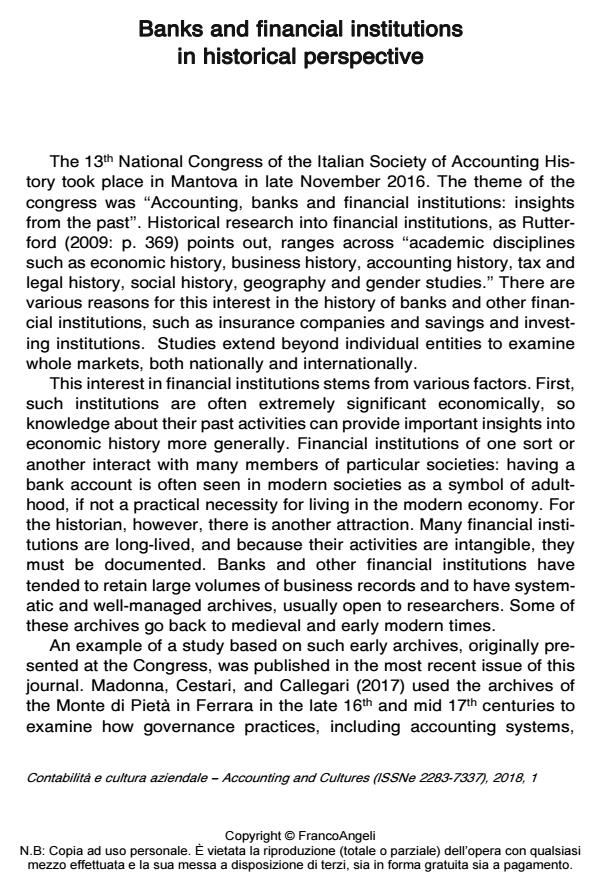Banks and financial institutions in historical perspective
Titolo Rivista CONTABILITÀ E CULTURA AZIENDALE
Autori/Curatori Valerio Antonelli, Nieves Carrera, Christopher Napier
Anno di pubblicazione 2018 Fascicolo 2018/1 Lingua Inglese
Numero pagine 4 P. 9-12 Dimensione file 53 KB
DOI 10.3280/CCA2018-001002
Il DOI è il codice a barre della proprietà intellettuale: per saperne di più
clicca qui
Qui sotto puoi vedere in anteprima la prima pagina di questo articolo.
Se questo articolo ti interessa, lo puoi acquistare (e scaricare in formato pdf) seguendo le facili indicazioni per acquistare il download credit. Acquista Download Credits per scaricare questo Articolo in formato PDF

FrancoAngeli è membro della Publishers International Linking Association, Inc (PILA)associazione indipendente e non profit per facilitare (attraverso i servizi tecnologici implementati da CrossRef.org) l’accesso degli studiosi ai contenuti digitali nelle pubblicazioni professionali e scientifiche
- Adamo S., Alexander D., and Fasiello R. (2018). Usury and credit practices in Italy in the Middle Ages. Contibilità e Cultura Aziendale, 1.
- De Roover R. (1956). The development of accounting prior to Luca Pacioli according to the account-books of medieval merchants. In: Littleton, A.C. and Yamey, B.S. Studies in the History of Accounting. London: Sweet & Maxwell, pp. 114-174.
- Hermann T. (2018). Accountable to nobody? The case of the Bank of German States. Insights from rhetorical analysis. Contabilità e Cultura Aziendale, 1.
- Lardo A., Lombardi R., Trequattrini R., and Cuozzo B. (2018). The rise and decline of the Bank of Italy’s autonomy between 1893 and 1936. A historical interpretation. Contabilità e Cultura Aziendale, 1.
- Madonna S., Cestari G., and Callegari F. (2017). Organisational and accounting responses to bankruptcy: The case of the Ferrara Monte di Pietà (1598 and 1646). Contabilità e Cultura Aziendale, 17(2): 71-102.
- Mann M. (1984). The autonomous power of the state: Its origins, mechanisms and results. European Journal of Sociology, 25(2): 185-213.
- Merkl-Davies D.M., and Brennan N.M. (2017). A theoretical framework of external accounting communication: Research perspectives, traditions, and theories. Accounting, Auditing & Accountability Journal, 30(2): 433-469.
- Napier C.J. (2009). Defining Islamic accounting: Current issues, past roots. Accounting History, 14(1-2): 121-144.
- Rutterford J. (2009). Finance and financial institutions. In: Edwards J.R. and
- Walker S.P. (eds.) The Routledge Companion to Accounting History. Abingdon: Routledge, pp. 369-389.
- Sangster A. (2016). The genesis of double entry bookkeeping. The Accounting Review, 91(1): 299-315.
- Yamey B.S. (1962). Accounting and the rise of capitalism: Further notes on a theme by Sombart. Journal of Accounting Research, 2(2): 117-136.
Valerio Antonelli, Nieves Carrera, Christopher Napier, Banks and financial institutions in historical perspective in "CONTABILITÀ E CULTURA AZIENDALE" 1/2018, pp 9-12, DOI: 10.3280/CCA2018-001002